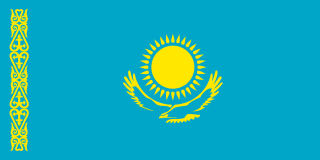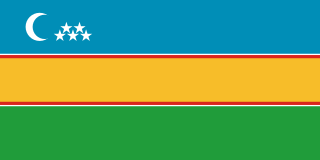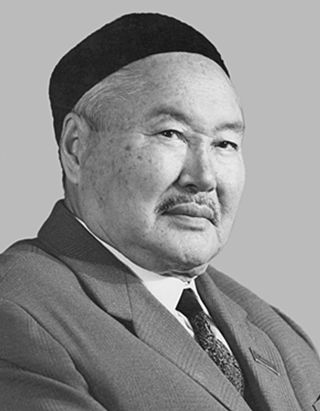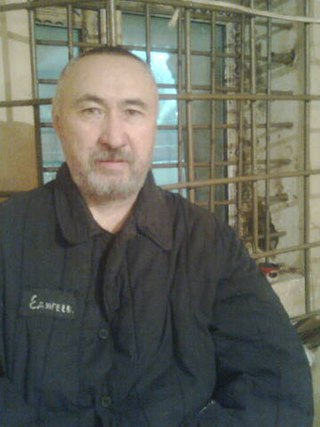
Kazakhstan, officially the Republic of Kazakhstan, is a landlocked country mostly in Central Asia, with a part in Eastern Europe. It borders Russia to the north and west, China to the east, Kyrgyzstan to the southeast, Uzbekistan to the south, and Turkmenistan to the southwest, with a coastline along the Caspian Sea. Its capital is Astana, while the largest city and leading cultural and commercial hub is Almaty. Kazakhstan is the world's ninth-largest country by land area and the largest landlocked country. It has a population of 20 million and one of the lowest population densities in the world, at fewer than 6 people per square kilometre. Ethnic Kazakhs constitute a majority, while ethnic Russians form a significant minority. Officially secular, Kazakhstan is a non-practicing Muslim-majority country, although ethnic Russians in the country form a sizeable Christian community.

Kazakhstan, the largest country fully within the Eurasian Steppe, has been a historical crossroads and home to numerous different peoples, states and empires throughout history. Throughout history, peoples on the territory of modern Kazakhstan had nomadic lifestyle, which developed and influenced Kazakh culture.

Ibrahim (Abai) Qunanbaiūly was a Kazakh poet, composer and Hanafi Maturidi theologian philosopher. He was also a cultural reformer toward European and Russian cultures on the basis of enlightened Islam. Among Kazakhs he is known simply as Abai.

Chagatai, also known as Turki, Eastern Turkic, or Chagatai Turkic, is an extinct Turkic language that was once widely spoken across Central Asia. It remained the shared literary language in the region until the early 20th century. It was used across a wide geographic area including western or Russian Turkestan, eastern or Chinese Turkestan, the Crimea, the Volga region, etc. Literary Chagatai is the predecessor of the modern Karluk branch of Turkic languages, which includes Uzbek and Uyghur. Turkmen, which is not within the Karluk branch but in the Oghuz branch of Turkic languages, was nonetheless heavily influenced by Chagatai for centuries.

The Kazakhs are a Turkic ethnic group native to Central Asia and Eastern Europe, mainly Kazakhstan, but also parts of northern Uzbekistan and the border regions of Russia, as well as northwestern China and western Mongolia. The Kazakhs arose from the merging of the medieval tribes of Turkic and Mongolic origin in the 15th century.
Music of Kazakhstan refers to a wide range of musical styles and genres deriving from Kazakhstan. Kazakhstan is home to the Kazakh State Kurmangazy Orchestra of Folk Instruments, the Kazakh State Philharmonic Orchestra, the Kazakh National Opera and the Kazakh State Chamber Orchestra. The folk instrument orchestra was named after Kurmangazy Sagyrbayuly, a well-known composer and dombra player from the 19th century.

Azerbaijani literature is written in Azerbaijani, a Turkic language, which is the official state language of the Republic of Azerbaijan, where the North Azerbaijani variety is spoken. It is also natively spoken in Iran, where the South Azerbaijani variety is used, and is particularly spoken in the northwestern historic region of Azerbaijan. Azerbaijani is also spoken in Russia, Georgia and Turkey.

Turkistan is a city and the administrative center of Turkistan Region of Kazakhstan, near the Syr Darya river. It is situated 160 km (100 mi) north-west of Shymkent on the Trans-Aral Railway between Kyzylorda to the north and Tashkent to the south. Its population has increased in ten years from 102,505 to 142,899. Turkistan's most prominent historical and cultural asset is the Mausoleum of Khoja Ahmed Yasawi, a UNESCO World Heritage site. The city is served by Hazrat Sultan International Airport.

The Karakalpaks or Qaraqalpaqs, are a Turkic ethnic group native to Karakalpakstan in Northwestern Uzbekistan. During the 18th century, they settled in the lower reaches of the Amu Darya and in the (former) delta of Amu Darya on the southern shore of the Aral Sea. The name "Karakalpak" comes from two words: qara meaning "black" and qalpaq meaning "hat". The Karakalpaks number nearly 871,970 worldwide, out of which about 726,000 live in the Karakalpakstan region of Uzbekistan.

Modern Kazakh culture is mainly characterized as a synthesis of Tengrian nomadic and Islamic and European elements. Nomadic elements derived from predecessors, such as the Huns, First Turkic Khaganate, Golden Horde and Kazakh Khanate. Nomadism largely shaped its peculiar music, clothing, jewelry and oral literature. Kazakh culture also seems to be strongly influenced by the nomadic Scythians.

Mukhtar Omarkhanuli Auezov was a Kazakh writer, a social activist, a Doctor of Philology, and an honored academician of the Soviet Union (1946).

Sabit Mukanov was a Kazakh and Soviet poet, writer, and academic. He was the head of the Writers' Union of Kazakhstan in 1936-37 and again from 1943 to 1952.

The National Library of the Republic of Kazakhstan (NLRK) is the national library of Kazakhstan. It acquires free legal copies of books, Republic and regional information, district journals, newspapers and other printed productions issued in Kazakhstan. In 2009, architect Bjarke Ingels designed the new National Library of Kazakhstan, located to the south of the State Auditorium in Astana, which is said to resemble a "giant metallic doughnut".
Yuri Alexeyevich Zuev or Zuyev was a Russian-born Kazakh sinologist and turkologist.
Jalair, also Djalair, Yyalair, Jalayir, is one of the Darliqin Mongol tribes according to Rashid-al-Din Hamadani's Jami' al-tawarikh. They lived along the Shilka River in modern Zabaykalsky Krai of Russia. After the Mongol conquest in the 13th century many Jalairs spread over Central Asia and the Middle East. Jalairs are one of the founding tribes of Mongolia's largest ethnic group Khalkha. Smaller clans named Jalayir are also found in Inner Mongolia in China. The Jalayirs who stayed in Central Asia under the rules of Genghis Khan's older sons' descendants eventually adopted Turkic language. They are found among the Kazakhs of the Great jüz; also they are found among the Uzbeks, Karakalpaks, and the Kyrgyz. The Jalairs who went to Iran and Iraq found the Jalairid Sultanate in 1330, and expanded into Turkey. The state was subjugated by the Kara Koyunlu in 1432.
Turkmen literature comprises oral compositions and written texts in the Old Oghuz Turkic and Turkmen languages. The Turkmens are direct descendants of the Oghuz Turks, who were a western Turkic people, who formed the Oghuz branch of the Turkic language family.
Shakarim Qudaiberdiuly (Kazakh: Шәкәрім Құдайбердіұлы, who was born 23 July [O.S. 11 July] 1858 in Ken-Bulak, Semipalatinsk Oblast and died 2 October 1931 in the Chinghistau tract, Soviet Union, was a Kazakh poet, Hanafi Maturidi theologian philosopher, historian, translator and composer. He is known for being a disciple and nephew of Abai Qunanbaiuly.

The Abai Square is a city square in Almaty, Kazakhstan. It is named after the Kazakh poet and enlightener Abai Qunanbaiuly whose monument is located in the middle. The square features a public garden and a number of fountains clad in granite. The square is located in front of the Palace of the Republic and around it are the Hotel Kazakhstan, Arman cinema, and a cable station linking to the Kók Tóbe Park.

Aron Qabyşūly Edigeev, better known as Aron Atabek, was a Kazakh writer, poet and dissident.
In June 2023, large forest fires broke out in the northeastern regions of Kazakhstan experienced its greatest annual death toll. While putting out the fires, at least 15 people died.














